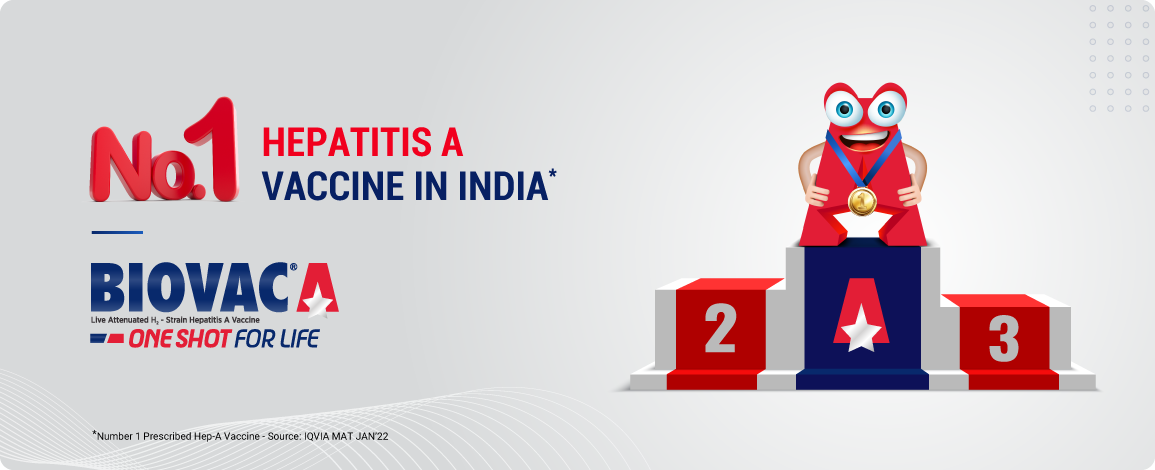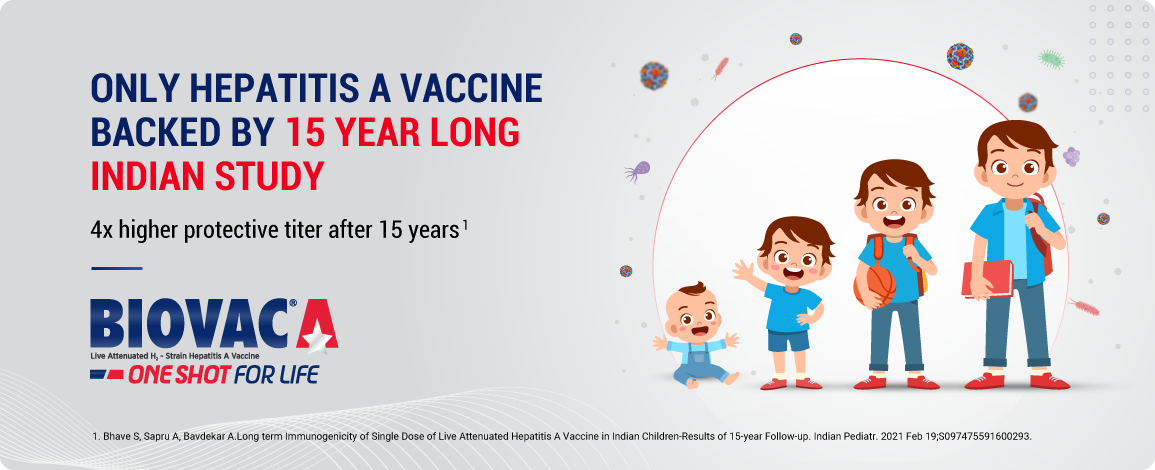Experts View
Leaders Opine on Protection from Hepatitis A with Vaccination
Knowlegde Hub
Latest Studies on Hepatitis A and its Vaccination

About Biovac A


Made from working seed virus the H2 attenuated strain of Hepatitis A Virus (HAV), cultured in Human diploid cells through a series of technological process
Hepatitis A is an acute liver disease caused by the Hepatitis A Virus (HAV). It is usually spread by close personal contact and by eating food or drinking water that contains HAV. The incubation period of acute Hepatitis A is usually 14–28 (up to 50) days. The clinical outcome is strongly correlated with age: while young children usually have asymptomatic infection, older children and adults commonly experience symptomatic disease.
• IAP recommended Hepatitis A Vaccine is used for long-term prevention of HAV infection in people who are one year old or older.
• WHO recommends vaccination against HAV for children aged ≥ 1 year.
Hepatitis A Vaccine should be kept and transported at a temperature +2°C to +8°C in a dark place. Do not use vaccine beyond the expiration date.
BIOVAC A: Pack of 0.5 ml vial of BIOVAC A along with 0.5 ml ampoule of sterile water for injection.
• Parenteral biological products should be inspected visually for extraneous particulate matter and/or discolouration before administration.
• If these conditions exist, the product should not be administered.
• Before injection, the skin over the site to be injected should be cleansed with a suitable germicide.
• Administer the vaccine subcutaneously. The preferred site is over the deltoid muscle. Do not administer over the buttocks.
• After insertion of the needle, aspirate to ensure that the needle has not entered a blood vessel. Do not inject intravenously.
Adverse events to Hepatitis A vaccine are usually mild and one would need to rest for a few days post vaccination for spontaneous recovery.
Local
• Pain at the site of injection
• Redness
• Swelling, Hematoma, Induration/Edema
• Pruritus
If treatment is needed, relevant treatment may be given.
Systemic
• Fever (>37.5°C axillary)
• Asthenia/Drowsiness
• Headache, Myalgia/Arthralgia
• Gastrointestinal disorders
• Behavioural changes, skin disorders
• The product is a live attenuated vaccine; the contact of the vaccine with any disinfectant should be avoided during manipulation.
• The product should not be used if it is found to have a crack in the vial, or unclear label, or turbidity after dissolution or the presence of foreign body.
• The vaccine should be given more than 3 months after gamma globulin administration.
• As with any parenteral vaccine, epinephrine should be available for use in case of anaphylaxis or anaphylactoid reaction.
• Prior to injection, with any vaccine, all known precautions should be taken to prevent adverse reactions. This includes a review of the patient’s history with respect to possible hypersensitivity to the vaccine.
• A separate syringe and needle must be used for each patient to prevent the transmission of infectious agents.
• Use by pregnant women is not recommended.
Abridged Prescribing Information
Biovac A Injection
Name of Medicinal Product-Biovac A. Generic Name: Live Attenuated Hepatitis A Vaccine. Form and strength-Pack of 0.5 ml live attenuated freeze-dried powder of hepatitis A vaccine vial along with 0.5 ml ampoule of sterile water for S/C injection. Dosage and administration: Add 0.5 ml sterile water to the vial, shake well till complete dissolution and inject sic as a single dose of 0.5ml in deltoid muscle of upper arm within 30 min of dissolution.DO NOT INJECT INTRAVENOUSLY. Storage & Transportation: It should be kept and transported at a temperature +2°C to +8°C in dark place and should not be used beyond the expiry date. Composition: Made from working seed virus the H2 attenuated strain of Hepatitis A Virus (HAV), cultured in Human diploid cells through a series of technological process. Specification: After re-dissolved in vial form, each 0.5 ml/dose contains Hepatitis A Live attenuated vaccine> 6.5 LgCCID50. Other Ingredients: Trehalose 24 mg; Dextran-40 4.5 mg; Sorbitol 9 mg; Mannitol 6 mg; Amino acids salts equilibrium solution 11.73 mg. lndication: The vaccine is indicated for active immunization against Hepatitis A in adults and children above 1 year age. Contraindications: Hypersensitivity to the vaccine or any component, acute infectious disease or other serious illness, acute febrile illness with temperature above 37.5 degree centigrade, immunological deficiency states, history of anaphylaxis or any other serious allergic reaction to vaccines. A minor afebrile illness or mild upper respiratory tract infection is not usually a reason to defer immunization with the vaccine. Adverse Reactions: usually mild & spontaneous recovery in few days. Local-pain at site of injection, redness, swelling, hematoma, induration, oedema, pruritus Systemic-fever(>37.5°C axillary),asthenia/drowsiness, headache, myalgia / arthralgia, GI or behavioural changes, skin disorders. Pharmacology: confers immunity by the inducing antibodies against the HAV. Warnings: It does not provide protection against infection of hepatitis B,C, D, E virus, or by other liver pathogens. lmmunocompromised persons (from disease or treatment) may not obtain the expected immune response. Vaccine may be ineffective if given during incubation period of Hepatitis A. Precautions: Being a live attenuated vaccine; avoid contact of vaccine with any disinfectant during manipulation; should not be used if crack in the vial/unclear label/turbidity after dissolution/the presence of foreign body. Keep gap of 3 months between vaccination and gamma globulin administration. Being a parenteral vaccine, follow universal precautions before injection including review of the patient's history with respect to possible hypersensitivity to the vaccine. Keep a preparedness for any adverse reaction including epinephrine readiness. A separate syringe and needle must be used. Use by pregnant women is not recommended.
Dated: 22nd September, 2020
Further information is available on request. Please refer to full prescribing information before prescribing this drug.
LMRC: GGI-CO-A1-VA1-300033370-300033370-WM-B22-791

















